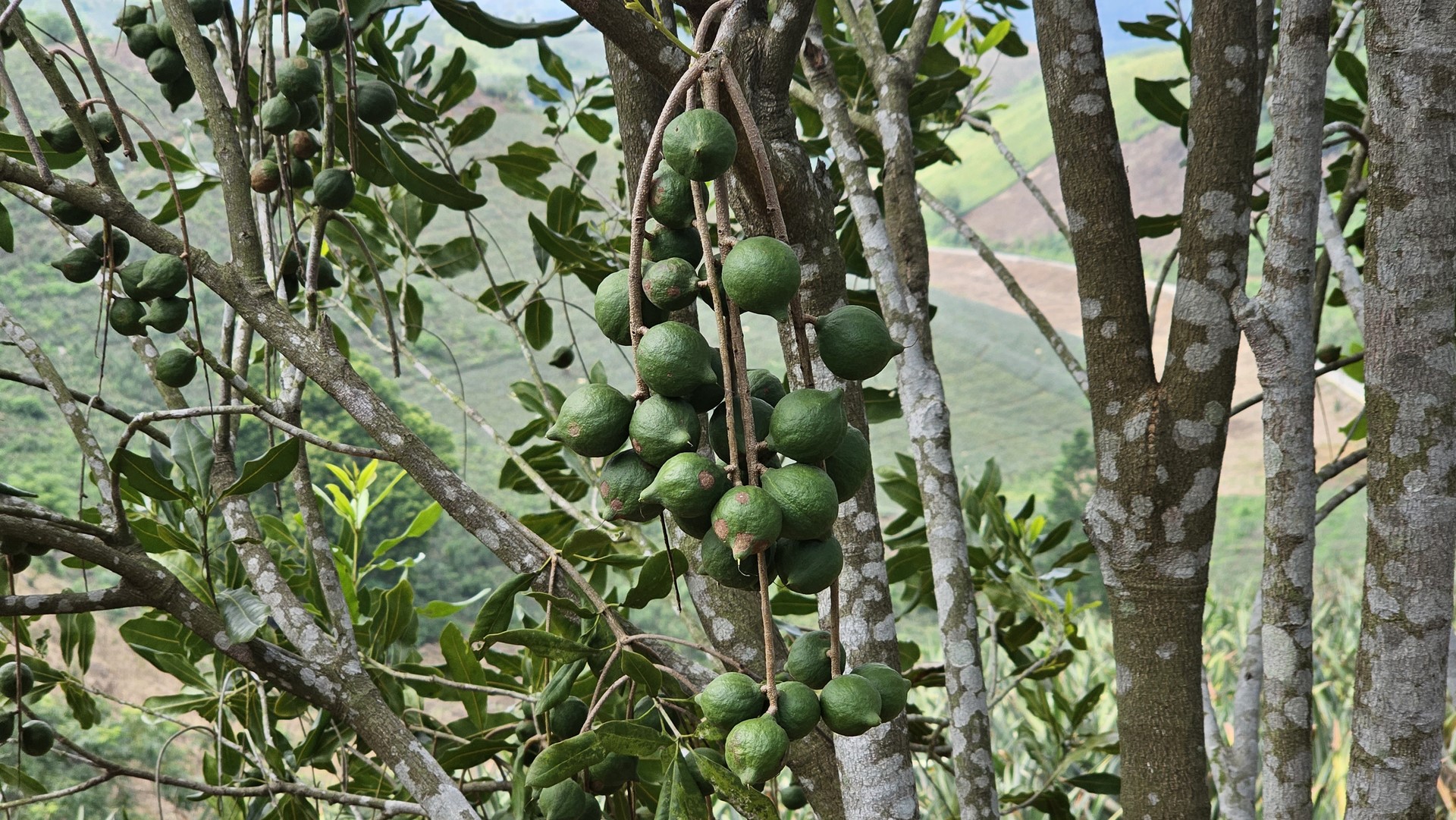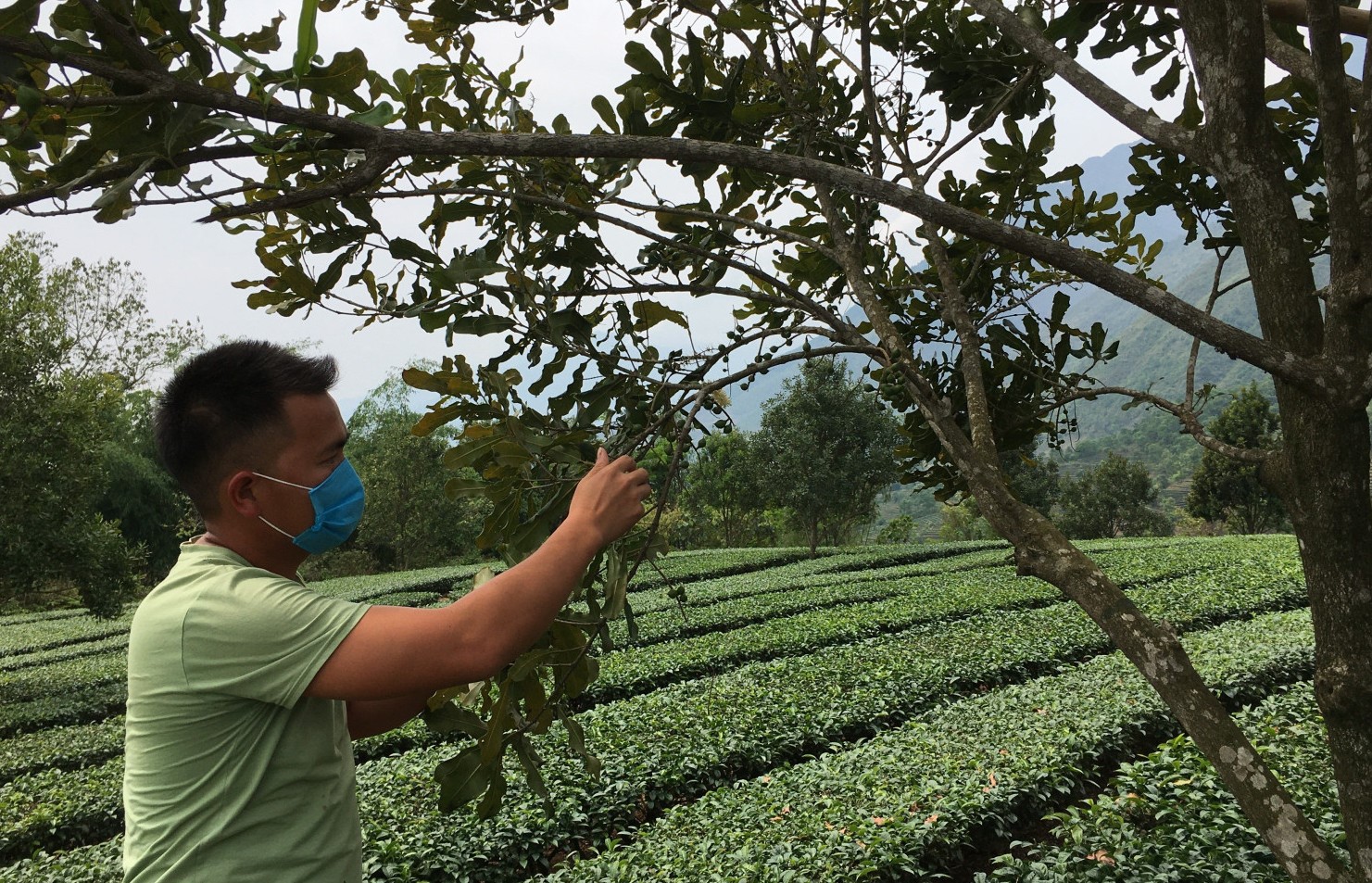November 25, 2025 | 02:43 GMT +7
November 25, 2025 | 02:43 GMT +7
Hotline: 0913.378.918
November 25, 2025 | 02:43 GMT +7
Hotline: 0913.378.918

Currently, a number of macadamia areas in Tam Duong district (Lai Chau) have initially shown positive results. Photo: T.L.
Since the program to develop temperate fruit trees was deployed in Tam Duong district (Lai Chau) in 2012, in Ban Hon commune (Tam Duong district), some households have boldly grown macadamia trees experimentally in an area of about 11ha. Thanks to the technical guidance from the specialized agencies, after five years of growing, the macadamia trees in the commune grew, developed well, and fruited. Up until now, the areas of experimentally grown macadamia trees have reached a relatively high and stable yield.
After those yielding and effective experimentally growing macadamia areas, people in Ban Hon commune have continued to expand the area. Up until now, Ban Hon commune has had about 136ha of macadamia trees.
Similarly, in Ban Bo commune (Tam Duong district), after experimental growing showed good results, Ban Bo commune has also expanded the macadamia growing area to more than 266ha. Ban Bo people have not grown macadamia merely but are mainly intercropped with tea trees.
Mr. Hang A Phinh from Nam Phat village in Ban Bo commune said that tea is a shade-loving plant. If the tea tree is shaded with 45–50% light intensity, it will give better yield and quality. Therefore, macadamia trees are intercropped with tea trees to help tea trees grow better and, at the same time, help people earn more income from macadamia trees.
"Intercropping macadamia with tea both saves space and brings good economic efficiency. In addition to income from tea, my family earns an additional VND 15 million/year from macadamia. So, in the coming time, I will continue to intercrop macadamia trees in the family's tea area," said Mr. Phinh.
However, the macadamia tree also suffers from a number of harmful diseases, such as nodular peel disease, stem fungal disease, and some diseases caused by stink bugs and insects that destroy young fruit. Thanks to the guidance on pest control from specialized agencies, the pests have also been well controlled. In addition, the farmers were also guided on the process of caring for, fertilizing, and weeding the macadamia tree, so the tree is now growing and developing well.
Currently, Tam Duong district (Lai Chau) is planning to develop the area of macadamia trees to about 1,600ha. In which, in the 2022–2030 period, the district will grow 1,000ha, including 400ha that will be grown merely; the rest will be intercropped. In the 2031–2050 period, this district will grow by 600ha.
According to Mr. Phong Vinh Cuong, Vice Chairman of the Tam Duong District People's Committee, the whole district now has more than 943ha of macadamia, with an output of about 1,033 tons/year and an estimated income of over VND 20 billion/year.

Macadamia trees are intercropped with tea trees in Ban Bo commune (Tam Duong district, Lai Chau province) both give high yields and help shade tea trees. Photo: T.L.
The district had just intercropped approximately 162ha of macadamia with tea in 2021 and 69ha in 2022. Of these, the state has supported more than 220ha, and Cisdoma Company has supported more than 10 ha in Ban Bo commune.
In Tam Duong district, macadamia growing areas are mainly concentrated in the following communes: Na Tam (134ha), Then Sin (171ha), Ban Bo (266ha), Khun Ha (58ha), Nung Nang (46ha), Ban Hon (136ha), Binh Lu (65ha), and Ban Giang (68ha). The structure of macadamia varieties includes nine lines: 741, 695, 842, 816, OC, 900, 849, 246, and 800. 100% of the above-mentioned macadamia growing areas belong to households and individuals.
In addition, the macadamia area of associated companies, according to value chains and linking production with product consumption, currently reaches more than 247ha. In particular, in 2020, International Macadamia Investment and Development JSC implemented value chain linkages, linking production with product consumption on a scale of more than 237ha. In 2022, Cisdoma Company cooperated to newly intercrop more than 10ha with tea in Ban Bo commune. The macadamia areas are currently growing and developing well.
However, some macadamia-growing projects are still slow to implement, such as the project area of the Lin Viet Lai Chau JSC used by people to cultivate fields, where the work of land surveying and clearance faces difficulties, and the work of road construction to the project as well as the reclamation have not been implemented, leading to the slow progress of the project.
The Tam Duong District People's Committee proposed to the Vietnam Macadamia Association that it pay attention to introducing businesses and investors to the district to survey and set up investment projects for macadamia tree development. Strengthen cooperation, exchange information, promote dissemination, and introduce and promote macadamia products to domestic and international organizations and individuals. The companies actively coordinate with specialized agencies in Tam Duong district to solve difficulties and problems during the project's implementation so that it can be put into operation on approved schedule.
Translated by Huyen Vu Thu

(VAN) Green transition is crucial for the Mekong Delta amid climate change and stricter standards, offering a path toward sustainability.

(VAN) Dong Thap promotes agricultural restructuring, forms large specialized farming zones, raises the value of agricultural products and develops toward ecological and high-tech directions.
/2025/11/22/4018-4-213342_747.jpg)
(VAN) The Mekong Delta Agricultural Experts Club has attracted 143 experts and researchers to participate in providing consultancy and contributing initiatives to the development of one million hectares of high-quality rice.

(VAN) Ca Mau’s development of OCOP products opens a path to increasing cooperatives value, helping boost income, expand markets, and affirm collective economy's role.

(VAN) Turning seemingly ordinary coconut shells into unique jewelry and artwork, Nguyen Bang Nhi spreads the value of local culture through her brand, Cocohand.

(VAN) Results from the Sustainable Durian Model Project in Dak Lak have confirmed the critical role of Yara Viet Nam in transferring advanced nutritional solutions to farmers.

(VAN) In Tuyen Quang province, livestock farmers have introduced effective models and innovative practices that significantly strengthen African Swine Fever prevention and control efforts.